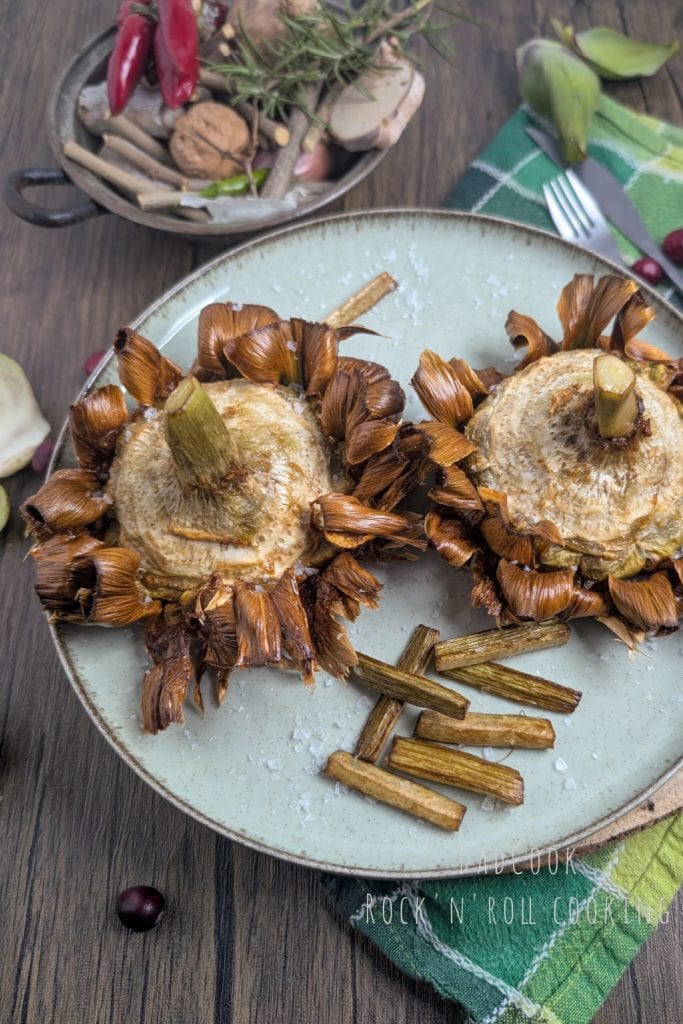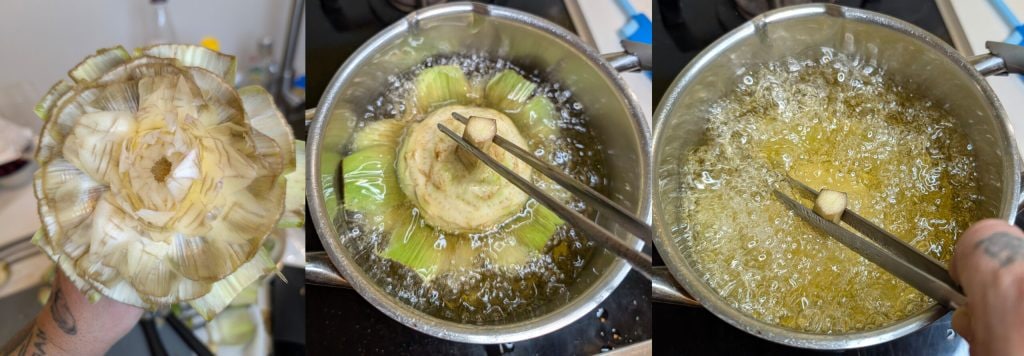There is a dish that, more than any other, takes me back in time, to family Sunday lunches and the aromas of grandma’s kitchen: artichokes alla giudia. Crispy on the outside, soft on the inside, with that unique flavor that only frying in hot oil can give. Artichokes alla giudia are a true triumph of taste and tradition. A classic of Roman cuisine, loved throughout Italy and appreciated abroad, artichokes alla giudia are a dish that cannot be missing from the tables of those who love good food. But how to achieve perfect frying that makes the artichokes crispy just right and evenly golden? Today I reveal my 5 secrets for preparing artichokes alla giudia that will make your mouth water!
I still remember the first time I tasted artichokes alla giudia. I was a child, and their peculiar appearance, similar to a golden flower, intrigued me a lot. At the first bite, it was love at first sight! Since then, artichokes have become one of my favorite vegetables, and the alla giudia recipe holds a special place in my heart (and my stomach!). From that day on, I experimented with different recipes and techniques for preparing artichokes alla giudia, in search of the perfect fry. And today I am happy to share with you my 5 secrets for impeccable results!

- Difficulty: Very easy
- Cost: Economical
- Rest time: 10 Minutes
- Preparation time: 20 Minutes
- Portions: 4
- Cooking methods: Frying
- Cuisine: Italian
- Seasonality: Autumn, Winter, Autumn, Winter, and Spring
- Energy 192.47 (Kcal)
- Carbohydrates 19.78 (g) of which sugars 1.86 (g)
- Proteins 6.16 (g)
- Fat 12.05 (g) of which saturated 2.06 (g)of which unsaturated 9.33 (g)
- Fibers 10.16 (g)
- Sodium 906.50 (mg)
Indicative values for a portion of 160 g processed in an automated way starting from the nutritional information available on the CREA* and FoodData Central** databases. It is not food and / or nutritional advice.
* CREATES Food and Nutrition Research Center: https://www.crea.gov.it/alimenti-e-nutrizione https://www.alimentinutrizione.it ** U.S. Department of Agriculture, Agricultural Research Service. FoodData Central, 2019. https://fdc.nal.usda.gov
Ingredients
- 4 mammole artichokes
- 6 ⅓ cups peanut oil
- to taste fine salt
Tools
- 1 Small Pot For Frying
Steps
Get a sharp knife, a bowl with cold water acidulated with lemon juice, and, if you want, a pair of gloves to protect your hands from blackening. Take the first artichoke and start by removing the tougher and fibrous outer leaves, about the first 2-3 layers. Continue peeling the artichoke gently, leaf by leaf, until you reach the more tender and lighter ones in the center. With a small knife, peel the stem, removing the tougher outer part, and shorten it to about 1.5-2 inches from the base. Cut off the upper part of the artichoke, removing about 0.4 inches of the tips of the leaves. Finally, slightly spread the leaves of the artichoke, as if forming a flower, and immerse it in the bowl with water and lemon to prevent it from blackening. Repeat the operation for all the artichokes.

Fill a large pot with plenty of peanut oil and heat it to a temperature of 284-302°F. Gently immerse the artichokes in the hot oil, one at a time, being careful not to overlap them. With tongs or a steel ladle, press each artichoke towards the bottom of the pot for the first few minutes of cooking, so the leaves open well and do not close during frying. This trick is essential to achieve the classic “flower” shape of artichokes alla giudia. Let the artichokes cook for about 8-10 minutes.

Let the artichokes cook for about 8-10 minutes, turning them occasionally. One minute before removing them from the pot, turn them on one side so that the stem is also well cooked, otherwise, it would remain too hard. Ensure the artichokes are soft inside and slightly golden outside.

After 8-10 minutes, drain the artichokes with a slotted spoon and let them rest on a tray lined with paper towels for a few minutes, to lose the excess oil. Meanwhile, raise the oil temperature to 338-356°F. When the oil is very hot, immerse the artichokes again, a few at a time, and let them fry for another 2-3 minutes, until they become crispy and evenly golden. Drain them again with the slotted spoon and place them on a new sheet of paper towels to remove excess oil.

Plate two artichokes per person on a serving dish. Lightly salt them and serve immediately, very hot, maybe accompanied by lemon wedges or homemade mayonnaise. First enjoy the outer leaves, super crispy and fragrant, detaching them one by one. Then, with a knife, cut the artichoke and savor the tender and delicious heart. Bon appétit!

Here are 5 secrets for a perfect fry:
Have you ever tried to cook artichokes alla giudia at home, but the result was not up to expectations? Don’t worry! With my 5 secrets, you will get artichokes that are crispy and golden just right, just like those from the restaurant.
The choice of artichokes:
For this recipe, it is essential to use Romanesco artichokes, also known as “mammole.” These artichokes have a round and compact shape, ideal for frying, and a sweet and delicate taste. Choose them fresh, with tightly closed leaves and firm stems.
The double fry:
The secret to obtaining artichokes alla giudia that are crispy on the outside and soft on the inside is the double fry. The first fry, at a lower temperature (284-302°F), serves to cook the artichokes internally. The second fry, at a higher temperature (338-356°F), gives the desired crispiness.
The temperature of the oil:
Maintaining a constant oil temperature during frying is essential for even cooking. Use a kitchen thermometer to check the temperature and adjust the stove flame accordingly.
Drying:
After the first fry, dry the artichokes well with paper towels before proceeding with the second. This will prevent oil splatters and help achieve a crunchier fry.
The salt:
Salt the artichokes only after frying, otherwise they will lose moisture and become mushy.
Extra tips:
Quality oil: prefer peanut oil for frying.
Thorough cleaning:
Remove the tougher outer leaves, the thorny tips, and the inner beard.
“Beating” the artichokes: before frying, gently beat the artichokes on a work surface to slightly open them like a flower.
Presentation:
Serve the artichokes hot, accompanied by lemon wedges.
By following these simple tips, your artichokes alla giudia will be a guaranteed success!
Serve the artichokes hot, accompanied by lemon wedges.
By following these simple tips, your artichokes alla giudia will be a guaranteed success!
Storage:
Artichokes alla giudia are best enjoyed when freshly made, when they are still hot and crispy. 😋 However, if you have any leftover artichokes, you can store them in the refrigerator for up to one day.
Here are some tips to store them in the best way:
Let them cool completely before storing them in the refrigerator.
Store them in an airtight container or wrapped in plastic wrap, to prevent them from absorbing refrigerator odors.
Do not stack them to prevent them from becoming soft.
Reheat them in the oven at 356°F for a few minutes before serving them, to make them crispy again.
I do not recommend freezing artichokes alla giudia, as frying tends to lose its crunchiness after thawing.
If you really must freeze them, I recommend doing so before the second frying. This way, you can thaw and fry them at the time of consumption, achieving a better result.
If you really must freeze them, I recommend doing so before the second frying. This way, you can thaw and fry them at the time of consumption, achieving a better result.
I hope these tips are helpful to you! 😊
I hope these tips are helpful to you! 😊
Wine Pairing
Artichokes alla giudia, with their crispiness and intense flavor, require a wine that cleanses the palate and balances the bitterness.
Generally, white wines are the best choice. Opt for fresh and savory whites, like Vermentino, Fiano, or Grechetto.
Even a full-bodied rosé, like Cerasuolo d’Abruzzo, can be a good match.
If you prefer red, choose it young, light, and low in tannins, like a Lambrusco di Sorbara served chilled.
Avoid full-bodied and tannic red wines, which may accentuate the bitterness of the artichoke.
FAQ (Questions and Answers)
What artichokes to use for the alla giudia recipe?
The best choice is Romanesco artichokes, also called “mammole.” They have a round and compact shape ideal for frying, with a sweet and delicate flavor. Make sure they are fresh, with tightly closed leaves and a firm stem.
The best choice is Romanesco artichokes, also called “mammole.” They have a round and compact shape ideal for frying, with a sweet and delicate flavor. Make sure they are fresh, with tightly closed leaves and a firm stem.
Can I fry the artichokes just once?
I do not recommend frying artichokes alla giudia only once. The double frying is the secret to achieving the right texture: the first at a lower temperature cooks the inside, the second at a higher temperature makes them crispy.
I do not recommend frying artichokes alla giudia only once. The double frying is the secret to achieving the right texture: the first at a lower temperature cooks the inside, the second at a higher temperature makes them crispy.
How to prevent artichokes alla giudia from becoming soggy?
To prevent the artichokes from becoming soggy, it is important to dry them well after the first fry and before the second. Also, salt them only at the end of cooking, otherwise, they will lose moisture.
To prevent the artichokes from becoming soggy, it is important to dry them well after the first fry and before the second. Also, salt them only at the end of cooking, otherwise, they will lose moisture.
Can I prepare artichokes alla giudia in advance?
Artichokes alla giudia are best enjoyed when freshly made. If you really must prepare them in advance, store them in the refrigerator for up to one day in an airtight container and reheat them in the oven before serving.
Artichokes alla giudia are best enjoyed when freshly made. If you really must prepare them in advance, store them in the refrigerator for up to one day in an airtight container and reheat them in the oven before serving.
How to know how many leaves to remove while cleaning artichokes?
Removing the right number of leaves is crucial for perfect artichokes alla giudia. Start by removing the tougher and fibrous outer leaves, usually the first 2-3 layers. Continue peeling the artichoke leaf by leaf until you reach the more tender and light green ones at the center. A trick to know if you have removed enough leaves is to bend one outward: if it breaks easily, it is ready to be removed. Remember that for this recipe, it is not necessary to remove too many leaves, as frying will make them soft and crispy anyway.
Removing the right number of leaves is crucial for perfect artichokes alla giudia. Start by removing the tougher and fibrous outer leaves, usually the first 2-3 layers. Continue peeling the artichoke leaf by leaf until you reach the more tender and light green ones at the center. A trick to know if you have removed enough leaves is to bend one outward: if it breaks easily, it is ready to be removed. Remember that for this recipe, it is not necessary to remove too many leaves, as frying will make them soft and crispy anyway.

